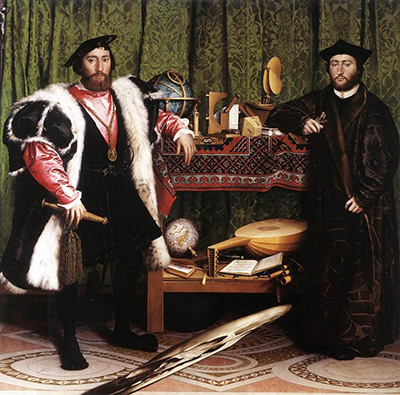The Ambassadors from 1533 is Hans Holbein the Younger's most famous painting and is also amongst the highlights of the National Gallery's collection in London, taking a prominent position within its permanent display.
This exquisite multi-figure portrait painting is also sometimes known as Jean de Dinteville and Georges de Selve as these are the names of the two men in this piece. Besides them, you will also spot some symbolic items included that aim to inform the viewer about the two individuals and their status within society. It was particularly common practice within the Renaissance, plus several art movements that followed on shortly afterwards, to display a subject's occupation through supplementary elements within the scene.
Jean de Dinteville stands on the left and was French ambassador to England at the time of this portrait. Georges de Selve stands on the opposing side of the composition and was the Bishop of Lavaur, although he held several other notable titles during his lifetime. The two individuals were friends at that time. Their ages of 25 and 29 are indicated by writing upon two of the men's possessions, namely a dagger and also a book.
The use of iconography in this and other paintings by Hans Holbein points to the influence of famous Netherlandish artist, Jan van Eyck, who did the same on many occassions. Hans Holbein was an intriguing mixture of styles that was caused, in part, by his German ancestry mixed with a passion for Netherlandish artists from the past. He also spent much of his life in England which again brought new influences and ideas into his work.




